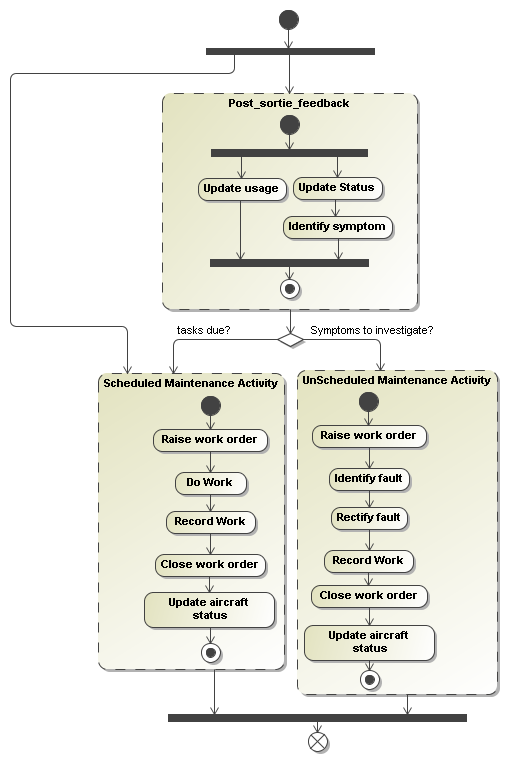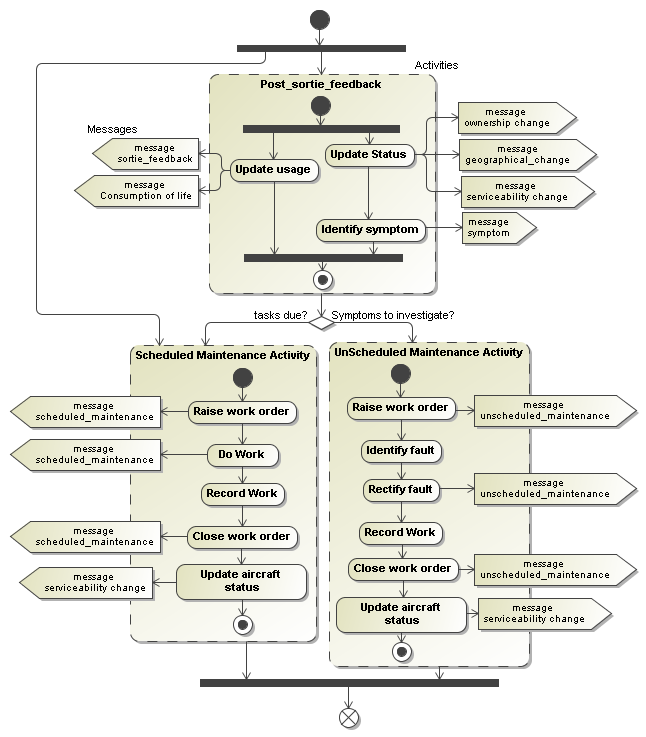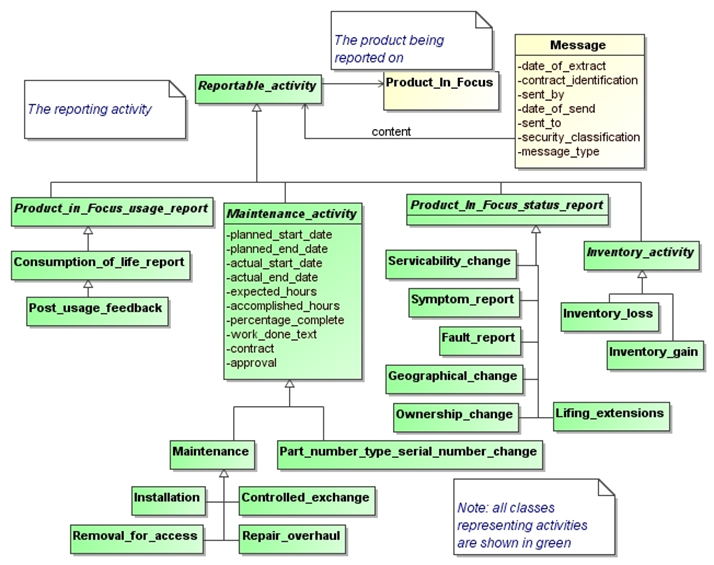| DEX: (D011) aviation_maintenance — Aviation maintenance |
Date: 2009/06/17 17:10:29
Revision: 1.154
|
Business Overview
This DEX enables the transmission of information reporting on:
- maintenance activities, both scheduled and unscheduled, that have been undertaken on
selected aircraft components and modules, referred to as Products In Focus;
- details of work done to the Products In Focus during a maintenance activity, including
removals, repairs, overhauls or rebuilds, installations and gains/losses to the aircraft
operators inventory;
- activities that have been performed by an aircraft or components that will affect
maintenance. For example, flying an aircraft or running an engine test will consume the
life of the components that may trigger a scheduled maintenance task;
- the status of a Product In Focus, such as fault states, symptoms and serviceability
state, of the aircraft and its components;
- inventory gains and losses.
This information is required by the aircraft operator and maintainers to effectively
manage and operate the Products In Focus. The use of this DEX is particularly relevant in
service based contracts where the operator and maintainer are different organisations with
the maintainer being responsible for ensuring a level of product availability. In these
situations, the DEX can be used to exchange product information between the two
organisations ensuring that the aircraft Product Configuration Information is accurate.
The business process for which the DEX provides information is summarized in the UML
activity diagram in Figure 3. This shows a product being
used, the authorization of scheduled or unscheduled maintenance, undertaking the maintenance
activity and then updating the aircraft status.
Information about the activities is collated, packed in the DEX and sent on. Typical
information includes details of the maintenance activity undertaken, by whom, on what date.
Information about the product on which the activity was done, (the Product In Focus), such as
what was replaced, what were the life measurements of the product, e.g hours flown. The
types of activities reported are described in Reportable activities.
NOTE
The process shown in Figure 3 is very high level and
intended to provide an overview.
Figure 3 — Typical business process using the Aviation Maintenance DEX
When the DEX is deployed, it is necessary to analyse the exact business process being
supported and to identify the points in the process where a data exchange is to be
triggered. This may vary from business to business. An illustration is provided in the UML
activity diagram in Figure 4 shown below which gives some
examples of where data exchanges typically take place. Namely:
- Sortie / post usage feedback: reporting after an aircraft has flown a sortie;
- Consumption of life: reporting when the life of a Product In Focus has been consumed;
- Ownership change: reporting after an aircraft has changed ownership;
- Geographical location change: reporting after an aircraft has changed geographical
location;
- Serviceability change: reporting after an aircraft has been removed from/returned to
service;
- Symptom: reporting when a symptom has been identified;
- Scheduled maintenance: reporting when scheduled maintenance starts and finishes.
Depending on the business there may be a series of triggers reporting on activities
performed during the maintenance, e.g. when parts are fitted, removed, exchanged etc.
- Unscheduled maintenance: reporting when unscheduled maintenance starts and finishes.
Depending on the business there may be a series of triggers reporting of activities
performed during the maintenance, when parts are fitted, removed, exchanged, faults
identified etc.
Figure 4 — Example exchange points
The following section outlines some of the activities that are reported by this DEX.
The following events about the usage of the Product In Focus are reported on by this DEX:
- Consumption of life
- Information about life units consumed by the Product In Focus and its component parts
following product usage.
- Sortie / post usage feedback
- Information about the usage of the Product In Focus, such as sorties flown, sortie
duration, take offs and landings, sortie profile, operating environment.
The following product status events are reported on by this DEX:
- Serviceability change
- This activity reports when the serviceability status of the Product In Focus changes
for any reason. Either a serviceable Product In Focus becomes unserviceable (cannot be
used), or an unserviceable Product In Focus becomes serviceable. For example, "rejection
due to a fault", "maintenance has become due" and "an operator has identified a fault".
- Symptom report
- This activity that produces a symptom report identifying an observation of Product In Focus
behaviour that was unexpected and affected the performance of the Product In Focus.
- Fault report
- This activity that produces a fault report identifying a state that renders a
Product In Focus unusable for its primary function.
- Geographical change
- This activity reports when a Product In Focus changes location. E.g. an asset is still
owned by the Air Force but changes geographical location
- Ownership change
- This activity reports when a Product In Focus changes ownership.
- Lifing extension
- This activity reports when the life measurement limits of a component are extended or
a concession to exceed the usage limits or limits to periodic maintenance activity or
task are granted. The activity reports the new life value, e.g. date, at which the
deferred maintenance activities or tasks are due.
The following sections outline the types of maintenance activities that may take place
during scheduled and unscheduled maintenance and are reported on by this DEX:
- Maintenance
- This activity records management information, such as approval, recording effort,
recording task completion, recording task coordination, about scheduled or unscheduled
maintenance activities and tasks. Typical activities are:
- Removal for Access
- This activity reports when a serviceable Product In Focus is removed from an
aircraft or component for access and the Product In Focus is then reinstalled.
- Removal and evacuation
- This activity reports when a serviceable or an unserviceable Product In Focus is
removed from an aircraft or component and the item is not reinstalled on the same
aircraft or component.
- Repair / Overhaul
- This activity reports when a serviceable or unserviceable Product In Focus is
removed from an aircraft or component for repair, overhaul, or rebuild.
- Installation
- This activity reports when a Product In Focus is installed on an aircraft or
component.
- Removal of Serviceable Products In Focus for Controlled Exchange
- This activity reports when any removal of a serviceable reportable component and
module from one aircraft for installation on another aircraft. This is done within
the same organization or in support of another organization. The installation on
another aircraft is reported as a separate, related activity.
- Part Number, Part type or Serial number Change
- This activity reports when the Part Number, Stock Code / Stock Number, and/or Serial Number
of a Product In Focus is changed as a result of a manufacturers work order or other
directive
The following Inventory activities are reported on by this DEX:
- Gains To Inventory
- This activity reports when a Product In Focus is first placed in the aircraft
operators inventory. This includes installed or uninstalled items. For example, when the
Product In Focus is received from the supplier by the operator.
- Loss to inventory
- This activity reports when a Product In Focus is removed from the operators inventory.
For example, when the Product In Focus has been decommissioned or transferred to another
operator.
The reportable activities described above are summarised by the UML class diagram in Figure 5.
Figure 5 — UML model representing reportable activities
©
OASIS
2010 — All rights reserved



